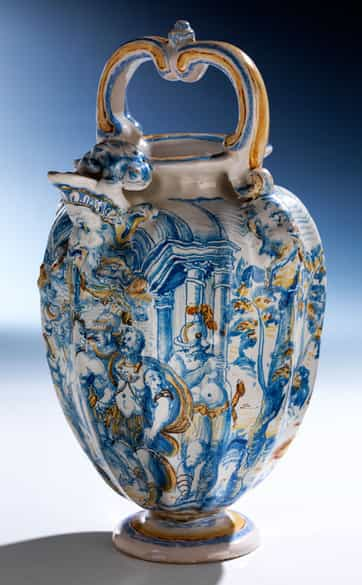Aste Maiolica
» rimettere
Il Vostro Art Agent personale

Volete acquistare un oggetto simile?
Volentieri Vi teniamo aggiornati, quando opere simili verranno offerte in una delle nostre prossime aste.
Vi preghiamo di accettare la nostra politica sulla privacy
542
Majolika-Bügelkanne wohl aus der Bottega dei Bettisi
Höhe: 31 cm.
Durchmesser des Fußes: 8,5 cm.
Faenza, letztes Viertel 16. Jahrhundert.
Prezzo del catalogo € 35.000 - 50.000
Prezzo del catalogo€ 35.000 - 50.000
$ 37,800 - 54,000
£ 31,500 - 45,000
元 273,700 - 391,000
₽ 3,482,150 - 4,974,500
Bügelkanne auf kleinem Fuß mit konischem Körper. Der Bügel aus zwei C-Schwüngen geformt. Spitzer Ausguss in Form einer Maske. Die gesamte äußere Seite ist dekoriert mit Istoriato-Bemalung. Zu sehen ist wohl die römische Geschichte von Syphax, der in Ketten nach Rom gebracht wird. Um Syphax stehen die römischen Soldaten und ein offener Bogen wölbt sich über den Häuptern. Links und rechts der Doppelsäulen sind Bäume zu sehen. Auf der Rückseite der Kanne eilt ein Mann mit Speer in der Hand. Die Bemalung in Blau, Orange und dunklem Ocker auf weißem Fond. Min. Glasurabplatzungen. Rest. Fuß, Henkel und Ausguss.
Anmerkung I:
Die Form der Kanne ist der zeitgenössischen Silberschmiedekunst entlehnt und war in der Gegend von Faenza verbreitet.
Anmerkung II:
Syphax, König von Westnumidien, war zunächst ein Verbündeter Roms gegen Karthago, bevor er die Seiten wechselte. Er bekriegte Scipio zuerst erfolgreich, doch wurde er von Scipio in seinem Heerlager überfallen und erlebte eine totale Nieder-lage. Er konnte sich zurückziehen, wurde aber bei einem erneuten Feldzug gefangen genommen und den Aufzeichnungen von Tacitus zufolge von Scipio verschleppt und starb dort.
Literatur:
Abgebildet bei Vincenzo de Pompeis, "La Maiolica Italiana di Stile Compendiaro. I bianchi", Turin London Venedig New York, 2010, S. 61, Nr. 11 und S. 136 f., Nr.11.
Provenienz:
Ein Teller wohl von Virgilotto Calamelli mit einer Bemalung in ähnlichem Stil, vgl. Elisa P. Sani, "Italian Renaissance Maiolica", V & A, London, 2012, S. 111, Nr. 135. (9300021)
Maiolica ewer, probably from the Bottega dei Bettisi
Height: 31 cm.
Base diameter: 8.5 cm.
Faenza, last quarter of the 16th century.
Ewer on a small foot with conical body. The handle is shaped from two C-curves. Pointed spout in form of a mask. Whole exterior surface decorated with Istoriato painting. The allegorical scene probably illustrates the Roman story of Syphax, who is brought to Rome in chains. Syphax is surrounded by Roman soldiers under an open archway. On either side of twin columns are trees. The reverseof the ewer depicts a man hurrying with a spear in his hand. Painted in blue, orange and dark ochre on a white ground. Minimal glazing chips. Restored foot, handle and spout.
Notes I:
The shape of the jug is borrowed from the designs of contemporary silversmiths and was manufactured in the region surrounding Faenza.
Notes II:
Syphax, King of West Numidia was initially an ally of Rome against Carthage, before changing sides. In waging war against Scipio, he was firstly victorious, but then having been attacked by Scipio at his army camp, suffered defeat. He managed to retreat, but was captured on a new campaign and was, according to Tacitus' records, kidnapped by Scipio whereupon he died.
Literature:
Depicted in Vincenzo de Pompeis, La maiolica Italiana di Stile Compendiaro. I bianchi, Turin, London, Venice, New York, 2010, p. 61, no. 11 and pp. 136 ff., no. 11.
Provenance:
A plate, probably by Virgilotto Calamelli painted in a similar style, see Elisa P. Sani, Italian Renaissance maiolica, V&A, London, 2012, p. 111, no. 135.
This object has been individually compared to the information in the Art Loss Register data bank and is not registered there as stolen or missing.
Il Vostro Art Agent personale
Volete essere informati quando nelle nostre prossime aste un’opera d’arte simile viene offerta? Attivate qui il Vostro Art Agent personale.
Vi preghiamo di accettare la nostra politica sulla privacy
Volete acquistare un oggetto simile?
Il Vostro Art Agent Comprare in Private Sale Date delle aste
I nostri esperti sono felici di assistervi personalmente nella Vostra ricerca di opere d′arte
Volete vendere un'opera simile?
Consegnate ora Vendita privata FAQ
Le vostre consegne sono sempre benvenute. Il nostro team sarà felice di assistervi personalmente in ogni fase trattative. Aspettiamo le vostre chiamate.
Contattate i nostri esperti
further catalogues Mobili | Dipinti XVI - XVIII secolo | Porcellana, argento, cristallo di rocca | Biblioteca | Sculture ed Artigianato | Ceramica | Maiolica | Hampel Living | Dipinti XIX - XX secolo | Arte russa | Arte moderna | Arte asiatica, Gioielli & Orologi | Libri, desegni ed incisioni | Arte popolare e Varia




























